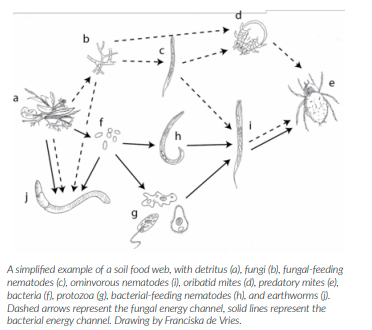Written by Franciska T. de Vries and Richard D. Bardget
There is much evidence that climate change significantly impacts the abundance, diversity and activity of soil biota, but few consistent effects are reported in the literature, and effects vary strongly depending on environmental context. – Elevated atmospheric CO2 increases microbial biomass and the abundance of fungi (moderate confidence), the abundance and body size of most faunal groups (moderate confidence), and thus causes changes in the structure of the soil food web (high confidence). Elevated CO2 has limited impacts on bacterial diversity (moderate confidence) – Warming increases the abundance of bacteria and fungi (high confidence) and of most soil faunal groups (moderate confidence), resulting in changes in the structure of the soil food web (high confidence) – Drought increases the abundance of fungi relative to bacteria (high confidence), but decreases the biomass and abundance of most microbial and soil faunal groups (high confidence).

Very little is known on the effects of increased rainfall and flooding on soil biota, and reported effects are highly context dependent – Changes in the abundance of soil organisms and the structure of the soil food web resulting from climate change will have consequences for soil functioning and the delivery of soilbased ecosystem services (high confidence). However, the relative importance of changes in soil biota compared to direct effects of climate change on soil functioning is unclear. Links between soil biota and soil functioning are context dependent, and specific processes and functional groups need further study. For example, the impact of climate change driven changes in soil biota on disease suppression, and the extent and consequences for soil functioning of invasive microbes, remain unexplored.
